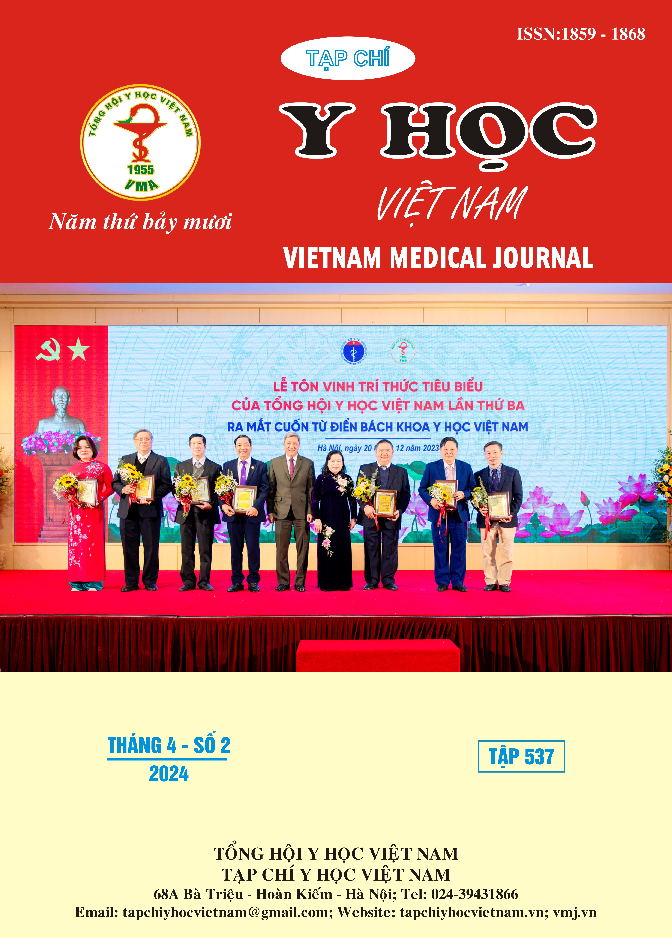ANTIBIOTIC RESISTANCE OF STREPTOCOCCUS PNEUMONIA-CAUSING SEPSIS IN CHILDREN IN THE PEDIATRIC INTENSIVE CARE UNIT AT VIETNAM NATIONAL CHILDREN’S HOSPITAL
Main Article Content
Abstract
Objective: To observe the antibiotic resistance of Streptococcus pneumoniae in pediatric patients with sepsis caused by S. pneumoniae. Subjects and methods: A retrospective descriptive study of a series of cases, including 46 pediatric patients from 1 month to 17 years old diagnosed with sepsis caused by S. pneumoniae treated at the Pediatric Intensive Care Unit, National Children Hospital, from January 2020 to August 2023. Results: patients with sepsis due to S. pneumoniae were infants (median age was 16 months). 44.8% of patients had one underlying disease (malnutrition, Down syndrome, thalassemia. For patients admitted with severe conditions, such as meningitis (43.5%), multiorgan failure (87%), and septic shock (58.7%), the morality of S. pneumoniae sepsis was very high (21.7%). Bacteria had a high rate of antibiotic resistance: the percentage of isolates sensitive to cefotaxime was 38.1%, and ceftriaxone was 34.9%. All of them were entirely resistant to clindamycin. There was a high rate of multidrug resistance: 65.2% (30/46). All isolates were sensitive to vancomycin, linezolid, and quinolones. Conclusion: S. pneumoniae has a high antibiotic resistance rate and is entirely vulnerable to vancomycin, linezolid, and quinolones.
Article Details
Keywords
Sepsis, Streptococcus pneumoniae, antibiotic resistance
References
2. Đặng Thị Soa, Vũ Thị Thủy, Trần Thị Oanh và cộng sự. Tổng quan về tình hình kháng kháng sinh của một số vi khuẩn thường gây bệnh trên lâm sàng tại Việt Nam từ 2017-2022. Tạp chí Y học Việt Nam, 2022. 519(1).
3. Goldstein B., Giroir B., Randolph A., et al. International pediatric sepsis consensus conference: definitions for sepsis and organ dysfunction in pediatrics. Pediatr Crit Care Med, 2005. 6(1): p. 2-8.
4. Weinstain MP, Lewis JS, Bobenchik AM, et al. Performance Standards for Antimicrobial Susceptibility Testing. 2020, Clinical and Laboratory Standards Institute. p. 82-87.
5. Nguyễn Đăng Quyệt, Đào Minh Tuấn, Bùi Quang Phúc và Trương Thị Việt Nga (2021). Tình hình đề kháng kháng sinh của phế cầu và kết quả điều trị viêm phổi do phế cầu ở trẻ em tại Bệnh viện Nhi Trung ương. Tạp chí Nghiên cứu và Thực hành Nhi khoa, 5(4), 27-34.
6. Li Q., Li Y, Yi Q, et al. Prognostic roles of time to positivity of blood culture in children with Streptococcus pneumoniae bacteremia. 2019. 38(3): p. 457-465.
7. Đào Hữu Nam, Nguyễn Thị Hồng Hà, Nguyễn Phương Hạnh và cộng sự. Mối liên quan giữa nồng độ đáy vancomycin và kết quả điều trị viêm màng não phế cầu ở trẻ em. Tạp chí Y dược Lâm sàng 108, 2023. Tập 18 - Số đặc biệt tháng 10 2023.
8. Trần Quang Khải, Nguyễn Thị Diệu Thúy, Đỗ Trần Hùng và cộng sự. Tỷ lệ phân lập, đề kháng kháng sinh của streptococcus pneumoniae gây viêm phổi nặng ở trẻ em Cần Thơ. Tạp chí Nghiên cứu Y học, 2021. 145(9): p. 229-240.


